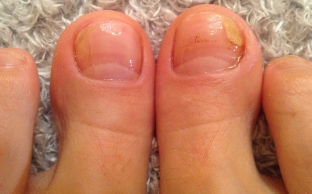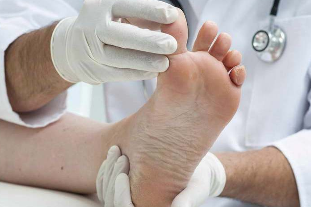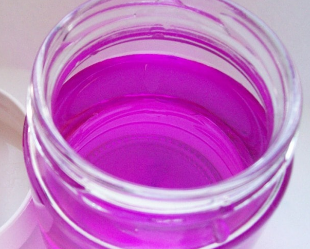The dark color of the nail, thickening, package, and distortion – all of these can be a sign of the development of nail fungus (onychomycosis). Many patients confuse the infection with injury or psoriasis. To avoid the deterioration of the disease, you need to know how to determine fungi on the nails of the feet, the types and the symptoms.
The species of fungus of the nail

Often fungal infection does not only apply to the nail and affects about-nail zone. Also suffers the skin of the foot and interdigital folds, such as the hands and the feet (athlete's foot). Among the most meetings of pathogenic organisms that cause negative changes can be distinguished:
- yeast fungi – hit the nail, making it thinner, which leads to detachment of the plate from the bed?
- dermatophytes – penetration of the stratum corneum, causing the appearance in this yellow stripes or spots of white color, which over time are on the increase?
- musty fungus – it penetrates into the upper layers of the plate and changes the color to green, grey or black.
When the infection affects the nails, in the early stages of the already visible the first changes, on the basis of which we can distinguish 3 main types of fungi.
- Distal onychomycosis. Defeat starts from the edge of the layer of the cornea, and then the infection moves to the base of the plate. The nail becomes grayish in color, thickens or thins, collapsing, and over time almost completely destroyed.
- Near fungus. Distributed with the center of the plate, causing a dark color and destruction.
- Superficial onychomycosis. It is accompanied by the appearance of white spots in the center nail or the edges. At the beginning of the disease isn't that funny distortion, but the touch felt the looseness, that over time leads to a change of the bed and loss of nail.
The first signs and symptoms of fungus nail
The development of the fungus does not flow hidden. Already a few days after the hit of the infection appear the first signs and symptoms, which over time become more and more luminous.
- Nail tarnish, lose its luster, change the image of the plate, yellow or white dots, longitudinal stripes.
- Changing the form of a nail, is the deformation, which is accompanied by a thickening or thinning of the stratum corneum. This situation leads to detachment, exhaustion, fun, and further separation of the bed.
- Result pain when pressure is applied. Stratum corneum and adjacent tissues inflammation.
- The appearance of the diaper rash between the fingers, and unpleasant odors from the affected nails.

The symptoms and signs help to identify the nail fungus in the early stages and to distinguish from other illnesses (bruises, psoriasis, eczema, depriving).
Methods of diagnosis
The procedure for the detection of onychomycosis or fungal infections usually passes through several stages, which include specific techniques: the clinical picture, microscopy.
Initially, the expert draws the attention to the symptoms and the complaint of the patient, who performs the collection of clinical data. After inspection of the plates and the skin around them, the doctor before it enhances the infection, while eliminating the relevant diseases (psoriasis, red shingles, problems with the normal power supply of the nail).
For accurate confirmation of the disease special do sampling of the material, to pass through microscopic examination. The affected area is taken scraping of tissue in laboratory conditions is treated with a special substance.
More accurately diagnose the type of fungus helps the study of the biological material. The analysis is done after the microscopy. The seed scraper. A sample of the affected tissue is placed in nutrient for the fungus environment. Within 3-5 days, you can get the results of the procedure. It is a kind of fungus you can learn about the structure of the colonies, their initial development and the specific color.
Thanks to biological research unmistakably determined by the type of virus and the sensitivity to certain antimicrobial drugs. This allows not only to reveal the exact of the pathogen of the infection, but also to get an effective treatment.
How to fix the fungus nail at home?
The dark color of the nail, the looseness and the exhaustion is not always may indicate onihomicose. To find out if there is a fungal infection can be used iodine and potassium permanganate.
We define onychomycosis with the help of potassium permanganate
The procedure for the identification of fungi takes a lot of time and easy to implement. In a basin of warm water to dilute it a little manganese, to get a weak solution. Place the wet hand or leg, wait for 5-10 minutes. During healthy nails turns to a brown color, the affected areas will remain unchanged.
Identification of fungi of the nails with the use of iodine
In contrast to manganese, iodine may not indicate the presence of pathogens onychomycosis. The tool helps to eliminate other fungi, in particular, tinea versicolor. If the skin around the nail appeared peeling, redness, you need these areas to treat iodine. Healthy skin is almost ceased to exist under the alcoholic solution, but is affected zoster places will be a rich dark color.
How to distinguish the athlete's nails of other diseases?
In the early stages of the development of fungal infection can be confused with skin diseases (psoriasis, herpes), or injuries of the nail. Not to run the negative symptoms, it is important to know the basic differences of the fungal growth.

- The dark color of the nail, the appearance of yellow spots and longitudinal stripes, which over time become more and penetrate deeper into the nail.
- Smooth progression of the disease without exacerbations and calm, as is the case with psoriasis. The fungus gradually deforms the nail plate, until manual removal of the bed.
- The appearance of an unpleasant odor and pain is also characteristic of the fungus from injuries or psoriatic defeat, eczema, depriving.
- Causes of occurrence of the fungus may visit the public areas (pool, sauna), wearing tight shoes (minor injuries and abrasions), increased sweating of the feet, diaper rash, as well as contact with an infected person.
- The fungus initially appears in a particular finger, often great, then it affects the rest of the column and the interdigital area.
Refer to the differences help us to identify fungus in the early stages of development. It is important to realize that self-diagnosis is not enough. For the effective treatment needs an examination by a specialist.
The athlete – nasty and insidious disease, which may be covered under other pathologies (psoriasis, eczema). It is important to carefully follow the claws and legs, and with suspicious symptoms the time to contact your doctor for early treatment.































